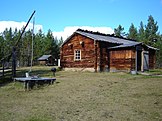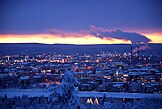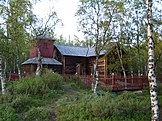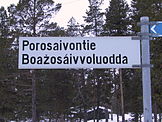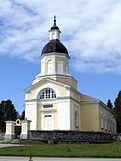Lapland (Finland)
Lapland
Lapin maakunta Lapplands landskap | |
|---|---|
 | |
| Country | Finland |
| Capital | Rovaniemi |
| Area | |
| • Total | 100,366 km2 (38,752 sq mi) |
| • Land | 7,699 km2 (2,973 sq mi) |
| • Water | 92,667 km2 (35,779 sq mi) |
| Population (2016-08-31) | |
| • Total | 179,997 |
| • Density | 1.8/km2 (4.6/sq mi) |
| Time zone | UTC+2 (EET) |
| • Summer (DST) | UTC+3 (EEST) |
| ISO 3166 code | FI-10 |
| Website | lapinliitto.fi |
| Symbols | |
| Bird | Bluethroat |
| Fish | Salmon |
| Flower | Globe-flower |
| Lake | Lake Inari |
| Mineral | Gold |
Lapland (Template:Lang-fi; Template:Lang-se; Template:Lang-sv) is the largest and northernmost region of Finland. The municipalities in the region cooperate in a Regional Council. Lapland borders the region of Northern Ostrobothnia in the south. It also borders the Gulf of Bothnia, Norrbotten County in Sweden, Finnmark County and Troms County in Norway, and Murmansk Oblast and the Republic of Karelia in Russia.
Geography
The area of Lapland region is 100,367 km², which consists of 92,667 km²of dry land, 6,316 km² fresh water and 1,383 km² of sea areas.[1] In south it borders Northern Ostrobothnia region, in west Sweden, in north and west Norway and in east Russia. Its borders follow three rivers: Tana, Muonio and Torne. The largest lake is Lake Inari, 1,102 km².[2] Highest point is on Halti, which reaches 1,324 m (4,344 ft) on Finnish side of the border.[3]
There are eight national parks in Lapland: Bothnian Bay, Lemmenjoki, Oulanka, Pallas-Yllästunturi, Pyhä-Luosto, Riisitunturi, Syöte and Urho Kekkonen National Park.
The very first snowflakes fall to the ground in late August or early September over the higher peaks. The first ground-covering snow arrives in average in October or late September. Permanent snow cover comes between mid-October and end of November, significantly earlier than in southern Finland. The winter is long, approximately seven months. The snow cover is usually thickest in early April. Soon after that the snow cover starts to melt fast.[4] The thickest snow cover ever was measured in Kilpisjärvi in 19 April 1997 and it was 190 cm.[5]
Due to the warming effect of the Arctic Sea, the coldest spot is not located in northernmost Lapland but in the north-western corner. The annual mean temperature varies from a couple of degrees below zero in Northwest to a couple fo degrees above zero in the southwest (Kemi-Tornio area).[6]
History
The area of Lapland was split between two counties of the Swedish Realm from 1634 to 1809. The northern and western areas were part of Västerbotten County, while the southern areas were part of Ostrobothnia County (after 1755 Oulu County). The northern and western areas were transferred in 1809 to Oulu County, which became Oulu Province. Under the royalist constitution of Finland during the first half of 1918, Lapland was to become a Grand Principality and part of the inheritance of the proposed king of Finland. Lapland Province was separated from Oulu Province in 1938.
During the Interim Peace and beginning of the Continuation War the government of Finland allowed the Nazi German Army to station itself in Lapland as a part of Operation Barbarossa. After Finland made a separate peace with the Soviet Union in 1944, the Soviet Union demanded that Finland expel the German army from her soil. The result was the Lapland War, during which almost the whole civilian population of Lapland was evacuated. The Germans used scorched earth tactics in Lapland, before they withdrew to Norway. Forty to forty-seven percent of the dwellings in Lapland and 417 kilometres (259 mi) of railroads were destroyed, 9,500 kilometres (5,900 mi) of roadways were mined, destroyed or were unusable, and 675 bridges and 3,700 kilometres (2,300 mi) of telephone lines were destroyed. Ninety percent of Rovaniemi, the capital of Lapland, was burned to the ground, with only a few pre-war buildings surviving the destruction.
After the Second World War, Petsamo municipality and part of Salla municipality were ceded to the Soviet Union. The decades following the war were a period of rebuilding, industrialization and fast economic growth. Large hydroelectric plants and mines were established and cities, roads and bridges were rebuilt from the destruction of the war. In the late 20th century the economy of Lapland started to decline, mines and factories became unprofitable and the population started to decline rapidly across most of the region.
The provinces of Finland were abolished on January 1, 2010, but Lapland was reorganised as one of the new regions that replaced them.[7]
Economy
| Jobs | 73,300 |
| GDP (million euros) | 5,600 |
| GDP (per capita) | €30,635
(84% Finland average) |
| Private and public offices | 10,400 |
| Private sector revenues (million euros) | 10,000 |
| Exports (million euros) | 3,400 |
| Private and public sector workers | 64,800 |
| Unemployment | 15.3% [9] |
Lapland's economy (2012)
Population
Lapland is the home of about 3.4% of Finland's population, and is by far the least densely populated area in the country. The biggest towns in Lapland are Rovaniemi (the regional capital), Tornio, and Kemi. In 2011, Lapland had a population of 183,320 of whom 177,950 spoke Finnish, 1,526 spoke Sami, 387 spoke Swedish and 3,467 spoke some other languages as their mother language.[10] Of the Sami languages, Northern Sami, Inari Sami and Skolt Sami are spoken in the region.
Lapland's population has been in decline since 1990.
| Year | Population |
|---|---|
| 1950 | 169,211 |
| 1955 | 189,176 |
| 1960 | 208,788 |
| 1965 | 221,162 |
| 1970 | 197,429 |
| 1975 | 195,131 |
| 1980 | 196,288 |
| 1985 | 200,571 |
| 1990 | 201,652 |
| 1995 | 200,579 |
| 2000 | 189,288 |
| 2005 | 184,935 |
| 2010 | 183,484 |
| 2015 | 180,858 |
Regional Council
The 21 municipalities of Lapland are organised into a single Region, where they cooperate in the Lapland Regional Council, Lapin liitto or Lapplands förbund.
Politics
Lapland has seven seats in the 200-place parliament of Finland. In Finnish parliamentary election, 2015 four seats went to Centre Party , and True Finns , Left Alliance and Social Democratic Party got one seat each.[11]
The votes were distributed as follows:
- Centre Party 42.9%
- True Finns 16.5%
- Left Alliance 13.7%
- National Coalition Party 10.1%
- Social Democratic Party 10.8%
- Green League 2.6%
- Christian Democrats 1.1%
- Swedish People's Party 0.5%
Sami Domicile Area
The northernmost municipalities of Lapland where the Sami people are the most numerous, form the Sami Domicile Area. Sami organization exists in parallel with the provincial one.
Municipalities
The region of Lapland is made up of 21 municipalities, of which four have city status (marked in bold).
| Municipality | Population (2014) |
Area (km²) |
Density (pop. per km²) |
Sub-Region | |
|---|---|---|---|---|---|
| Rovaniemi | 61,568 | 8,016.84 | 8.02 | Rovaniemi | |
| Tornio | 22,333 | 1,348.85 | 18.84 | Kemi-Tornio | |
| Kemi | 21,939 | 747.51 | 232.23 | Kemi-Tornio | |
| Sodankylä | 8,825 | 12,415.48 | 0.76 | Northern Lapland | |
| Keminmaa | 8,474 | 647.23 | 13.69 | Kemi-Tornio | |
| Kemijärvi | 7,889 | 3,930.91 | 2.29 | Eastern Lapland | |
| Inari | 6,818 | 17,333.54 | 0.45 | Northern Lapland | |
| Kittilä | 6,469 | 8,262.94 | 0.79 | Fell Lapland | |
| Ylitornio | 4,454 | 2,212.38 | 2.22 | Torne Valley | |
| Ranua | 4,093 | 3,694.80 | 1.21 | Rovaniemi | |
| Kolari | 3,842 | 2,617.77 | 1.51 | Fell Lapland | |
| Salla | 3,789 | 5,873.08 | 0.68 | Eastern Lapland | |
| Pello | 3,674 | 1,863.68 | 2.17 | Torne Valley | |
| Posio | 3,636 | 3,544.81 | 1.20 | Eastern Lapland | |
| Simo | 3,299 | 2,086.39 | 2.34 | Kemi-Tornio | |
| Tervola | 3,238 | 1,592.04 | 2.12 | Kemi-Tornio | |
| Muonio | 2,375 | 2,037.80 | 1.25 | Fell Lapland | |
| Enontekiö | 1,892 | 8,391.35 | 0.24 | Fell Lapland | |
| Utsjoki | 1,259 | 5,372.01 | 0.25 | Northern Lapland | |
| Savukoski | 1,100 | 6,495.95 | 0.17 | Eastern Lapland | |
| Pelkosenniemi | 949 | 1,881.57 | 0.53 | Eastern Lapland | |
| Total | 181,815 | 100,366.93 | 1.97 |
Heraldry
The Regional Council of Lapland uses the Finnish variation of the coat of arms for Laponia. The coat of arms for the Province of Lapland was composed out of the coats of arms of Laponia and Ostrobothnia.[dubious – discuss]
Lapland's impact on Finnish numismatics
Most of the gold used to mint Finnish gold coins comes from Lapland. Lapland itself has been the main motif for a recent commemorative coin, the First Finnish gold euro commemorative coin, minted in 2002. On the reverse side, the midnight sun above a lake in Lapland can be observed.
Gallery
This section contains an unencyclopedic or excessive gallery of images. |
-
Riisitunturi National Park in Posio, southern Lapland is renowned for its crown snow trees
-
Saana fell in Enontekiö with Lake Kilpisjärvi in northwesternmost Finland; one of the most recognized landscapes in Finland
-
A traditional Lapponian timber house in Siida museum
-
Rovaniemi, the capital of Lapland, during wintertime
-
Santa Claus Village in Rovaniemi; tourism is crucial to Lapland's economy
-
Sámi people celebrating Easter
-
River Tornio near Ylitornio town
-
Flag of Sámi
-
Levi, a ski resort in Kittilä
-
Lapland was burnt down almost totally in World War II (Sodankylä)
-
Enontekiö Church, a typical after-World War II-erected church
-
Reindeer in Enontekiö
-
Utsjoki Church and church cabins; the northernmost church in Finland
-
Tornio Town Hall
-
Wilderness in Enontekiö
-
A view towards Lake Inari
-
A general view of Kemi town centre with Gulf of Bothnia in the background
-
Pallastunturi Fell in Muonio in wintertime twilight
-
Pielpajärvi Wilderness Church from 1760 managed to avoid getting burnt in World War II
-
Kemijärvi town centre
-
A giant's kettle in Salla, one of the largest in the world
-
A bilingual (Finnish and Sámi) street sign
-
A view from Saana fell
-
Architecture in Kemi
-
Keminmaa Church
-
Lake Iso-Vietonen, Ylitornio
-
River Kevo in Utsjoki
-
Sami boots in a museum in Rovaniemi
-
An old gold mine in Inari
-
Kolari Railway Station, the northernmost in Finland
-
Pihtsusköngäs Waterfall, Enontekiö
-
Lappia House in Rovaniemi, a culture venue designed by Alvar Aalto
-
Ranua Church
-
Isokuru Canyon, Pelkosenniemi
-
Traditional North-Osthrobothnian house in Tornio
-
Lake Peltojärvi in Inari
-
A view from Haparanda, Sweden to Tornio; the two towns are located so close, divided only by a river, that they're called a twin-town
-
A view from the annual Snow Castle in Kemi
-
A Sámi shaman drum mask
-
A polar bear in Ranua; though in a zoo
See also
Notes
- ^ "Suomen pinta-ala kunnittain 1.1.2016" (PDF). National Land Survey of Finland. Retrieved 21 November 2016.
- ^ "Lake Inari". Encyclopedia Britannica. Retrieved 21 November 2016.
- ^ "Mount Halti". Encyclopedia Britannica. Retrieved 21 November 2016.
- ^ "Snow statistics". Finnish Meteorological Institute. Retrieved 21 November 2016.
- ^ "Sääennätyksiä" (in Finnish). Finnish Meteorological Institute. Retrieved 21 November 2016.
{{cite web}}: Cite has empty unknown parameter:|1=(help) - ^ "Present climate - 30 year mean values". Finnish Meteorological Institute. Retrieved 21 November 2016.
- ^ "New regional administration model abolishes provinces in 2010". Helsingin Sanomat International Edition. Sanoma Corporation. 31 December 2009. Retrieved 1 January 2010.
- ^ "Lapin suhdannekatsaus 2013" (PDF). Lapin liitto. 19 August 2013. Retrieved 22 December 2013.
- ^ http://yle.fi/uutiset/tyottomyyden_musta_siipi_varjostaa_lappia/6953635
- ^ Statistics Finland – Statistical databases
- ^ "Candidates elected Electoral district of Lapland". vaalit. Elections website of the Ministry of Justice. Retrieved 21 November 2016.
External links
- Lapland Regional Council – Official site
- Lapland State Provincial Office – Official site
- Lapland Club
 Finnish Lapland travel guide from Wikivoyage
Finnish Lapland travel guide from Wikivoyage- Kemi-Tornio University of Applied Sciences – video portal – Videos about Lapland experiences and lifestyle.
- Levi-Lapland – Information on Lapland, the ski resorts and the Lapland Super Pass.
- Midnight Sun Film Festival

























